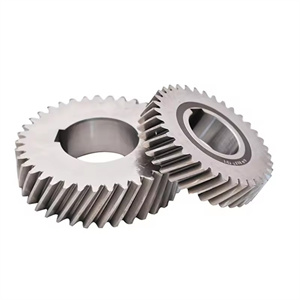Machining the production of spur bevel gears is a manufacturing process that is difficult but very important. Straight bevel gears play a crucial role in transmitting power and changing the direction of motion in mechanical transmission, and are widely used in fields such as automobiles, machine tools, and ships. In the machining process, the first step is to select materials. High strength and wear-resistant alloy steel, such as 20CrMnTi, is usually chosen. Then there is the preparation of the blank. Common methods include forging and casting to obtain a rough gear shape. Next is the machining of tooth profile. This is the core link in the entire production process, and the following methods are generally used:
Gear shaping: Using a gear shaping machine, the tooth shape is cut through the reciprocating motion of the cutting tool.
Milling: Using a milling machine and specialized milling cutters for machining.
In the process of tooth profile machining, it is necessary to accurately control the motion trajectory and cutting parameters of the tool to ensure the accuracy and surface quality of the tooth profile. For example, for spur bevel gears with high precision requirements, multiple tool passes and fine tool adjustments will be used to reduce errors. After processing, heat treatment such as carburizing and quenching is required to improve the hardness and wear resistance of the gears. At the same time, in order to ensure the transmission accuracy and meshing performance of the gears, precision machining processes such as tooth surface grinding and honing will also be carried out.
In terms of quality inspection, strict measurement will be carried out on various parameters of gears, including tooth pitch, tooth profile error, tooth orientation error, etc. Machining and producing spur bevel gears is a complex and delicate process that requires strict process control and high-precision equipment support in order to produce high-quality products that meet usage requirements.
Using CNC milling to produce gears is a common and efficient method. CNC milling machine tools can precisely perform milling operations according to preset machining programs through computer control, thereby producing gears that meet the requirements. The following are the main steps for producing gears using CNC milling:
Design:
Use CAD (computer-aided design) software to draw the geometric shape of gears, including key parameters such as tooth number, pressure angle, modulus, and tooth profile curve.
After the design is completed, save the CAD file in a format recognized by CNC milling machines, such as DXF, DWG, or IGES.
Material selection:
Select appropriate materials based on the usage and performance requirements of gears. Common metal materials such as steel, stainless steel, aluminum, etc. can be used in the manufacturing of gears.
Programming:
Use CAM (Computer Aided Manufacturing) software to convert CAD designs into machining programs that can be executed by CNC milling machines. This includes defining parameters such as cutting tools, cutting paths, cutting speeds, feed rates, etc.
For gear machining, special attention should be paid to the precise generation of tooth profile curves and the optimization of cutting paths to ensure the accuracy of gear tooth profile and surface quality.
Set up CNC milling machine:
Fix the selected material on the workbench of the CNC milling machine and install appropriate fixtures to ensure the stability of the material.
Install and adjust cutting tools, such as milling cutters or gear specific cutting tools, according to the machining program.
Processing:
Start the CNC milling machine and start the machining process. The machine tool will automatically perform milling operations according to the machining program, gradually processing the material into the shape of gears. During the machining process, CNC milling machines continuously monitor the position and status of cutting tools to ensure machining accuracy and quality.
Post processing:
After processing, perform necessary post-treatment on the gears, such as removing burrs, heat treatment (such as carburizing to improve hardness and wear resistance), coating, etc. Conduct quality inspection on gears, including size measurement, accuracy testing, surface quality inspection, etc., to ensure that they meet design requirements.
